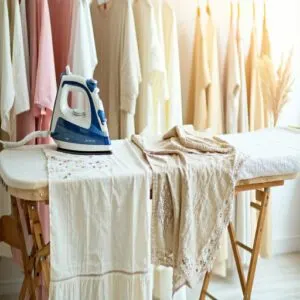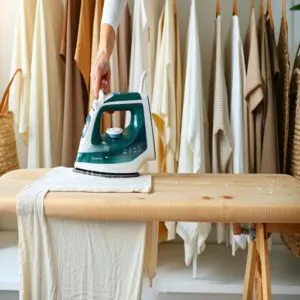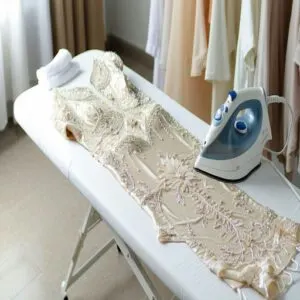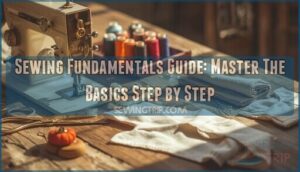This site is supported by our readers. We may earn a commission, at no cost to you, if you purchase through links.
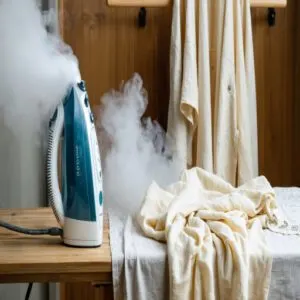 The best way to iron different fabrics is all about matching the heat and technique to the material.
The best way to iron different fabrics is all about matching the heat and technique to the material.
For cotton and linen, crank up the steam and use high heat to tackle stubborn wrinkles.
Silk? Go low heat, turn it inside out, and cover with a pressing cloth to avoid burns.
Wool loves a damp press cloth and gentle heat.
Synthetics like polyester need low heat, no steam, and a protective towel.
Always check your iron’s settings first—guesswork is a recipe for scorch marks!
With the right tools and care, even tricky materials become smooth, and the secret’s in the prep!
Table Of Contents
Key Takeaways
- Match your iron’s heat and steam settings to the fabric type to avoid damage and get the best results.
- Use a pressing cloth for delicate fabrics like silk, wool, and synthetics to prevent scorching or shine.
- Always iron clothes inside out if they have embellishments or are prone to damage from direct heat.
- For deep wrinkles, lightly dampen the fabric or use steam on sturdy materials like cotton and linen.
Ironing Fabric Types
Knowing how to iron different fabrics helps you avoid damage and achieve crisp results. Each fabric type needs a specific combination of heat, steam, and technique for the best outcome.
Cotton and Linen Ironing
Tackling cotton care and linen wrinkles? Start by spritzing fabric with water for softening.
Set your steam settings to high for effective wrinkle removal. Follow linen ironing instructions by moving smoothly to prevent scorching.
Use a pressing cloth for protection. These ironing tips make ironing cotton clothes and reshaping linen a breeze.
Remember to hang garments immediately after ironing to keep them crisp.
Silk and Synthetic Ironing
To master silk ironing methods, keep the fabric slightly damp, use low heat, and always iron inside out with a pressing cloth.
For wrinkle removal on synthetic fabrics, opt for low heat, skip the steam, and cover with a towel.
These fabric care tips and ironing tricks protect delicate items like silk finishing and synthetic blends from damage.
Understanding jute ironing techniques is also essential for working with natural fibers and achieving the best results.
Wool and Delicate Fabric Ironing
When ironing wool or delicate fabrics, precision is key to avoid common ironing mistakes.
Follow this wool ironing guide to keep your clothes flawless:
- Use low heat and a pressing cloth for delicate handling.
- Always iron wool inside-out to prevent shine.
- Slightly dampen fabrics to avoid fabric shrinking.
- Avoid direct steam; use steaming techniques carefully.
- Cool fabric before hanging.
Choosing Iron Settings
Choosing the right iron settings is essential for protecting your fabrics and achieving smooth results.
Match the temperature and steam levels to the fabric type, and you’ll prevent damage and get professional-looking finishes every time.
Adjustable Heat Settings
Every fabric’s a diva, demanding its own heat settings to look its best.
Your iron’s adjustable heat controls are your backstage pass to winning this game, and following the ironing temperature guide closely is crucial—cotton loves high heat, while silk thrives on low.
Modern irons with fabric sensors and smart ironing features guarantee flawless heat distribution, making thermal regulation simple and stress-free.
Effective iron temperature control systems, such as those using advanced temperature settings, can greatly improve ironing results.
Steam Function Benefits
Steam ironing benefits go beyond just eliminating wrinkles.
The steam function boosts fabric smoothing and guarantees efficient wrinkle removal.
To get the most out of your steam iron:
- Use proper steam settings for Heat Control.
- Keep the water reservoir filled for consistent Moisture Management.
- Iron thicker fabrics like cotton with steam bursts.
- Try vertical steaming for long curtains or coats.
Preventing Fabric Damage
Protecting fabrics while ironing safely isn’t tricky if you know the basics of ironing.
Always match the iron’s heat to the fabric type—wrong settings lead to burns and damage.
Use steam wisely for wrinkle resistance, but avoid overdoing it.
A pressing cloth is your secret weapon against scorch prevention.
To achieve smooth seams and prevent issues, understanding fabric puckering causes is essential for any sewing project.
Check out this quick guide:
| Wrinkle Resistance |
|---|
| Cotton/Linen |
Ironing Tools and Accessories
The right tools make ironing easier and help protect your fabrics. A reliable steam iron, pressing cloth, and sturdy ironing board are essential for smooth, professional results.
Steam Iron Features
Getting smooth results while ironing different fabrics means knowing your iron’s features.
Look for adjustable Steam Control to tackle tough wrinkles or keep things light for delicates, and a clear Water Reservoir helps you avoid mid-session refills.
A well-designed Soleplate guarantees even heat distribution, and Steam Pressure is your secret weapon for efficiency with fabrics like cotton and linen.
Understanding the benefits of a Steam Iron can greatly improve your ironing experience and results.
Pressing Cloth Uses
A pressing cloth is your secret weapon for fabric protection and scorch prevention.
It’s a must for delicate care and shine reduction when ironing different fabrics.
Here’s why:
- Prevents direct heat damage on sensitive materials.
- Protects embellished or printed surfaces.
- Reduces shine on dark fabrics.
- Guarantees smoother results with safer ironing techniques.
Using a pressing cloth product can greatly enhance your ironing experience.
Perfect for your fabric care tips toolbox!
Ironing Board Importance
A sturdy ironing board isn’t just furniture—it’s your secret weapon.
Quality ironing surfaces, like heat-resistant board covers, safeguard fabrics and enhance results.
Opt for ergonomic designs to save your back, and consider foldable boards for easy storage, while tabletop ironing boards work in tight spaces.
Always choose durable board cover materials for prolonged use.
To minimize damage, understanding ironing board marks is essential for perfect ironing results.
| Benefit |
|---|
| Heat Resistance |
Ironing Techniques and Tips
Mastering ironing techniques guarantees your fabrics look crisp without damage. Use the right method for each material to prevent shine, scorching, or mishaps with delicate details.
Damp Ironing Methods
Using damp fabric ironing speeds up wrinkle removal, making your clothes look great faster.
Slightly damp items, like dress shirts or linens, work wonders with steam control and the right ironing temperature.
Keep these fabric ironing tips in mind:
- Thicker fabrics like cotton need moisture for deeper creases.
- Synthetic fabrics benefit from light fabric dampening.
- Delicate items demand careful, gentle steam ironing.
Understanding fabric ironing techniques is essential for perfect results.
Preventing Shine and Scorch
Shiny patches and scorched spots don’t have to ruin your laundry day.
For effective fabric protection, avoid using high heat on delicate items like silk or polyester—low heat is your best ally.
Always use a pressing cloth to prevent scorching, especially when ironing synthetic fabrics.
Here’s a quick guide:
Fabric
| Heat Setting | Tips for Iron Safety |
|---|---|
| Silk |
Burning prevention starts with heat control—check settings every time.
Understanding jute ironing techniques is essential for working with this unique fabric.
Ironing Embellishments Safely
Avoid ironing embellished fabrics without care—it’s recipe for disaster.
Protect details like sequins or beads with these tips:
- Flip It Inside Out: Always iron on the reverse side of beaded garments.
- Use a Pressing Cloth: Prevent heat damage and sticking on delicate trim.
- Skip Steam: Steam can loosen adhesives.
Stick with low heat for special care fabrics.
When ironing fabrics like spandex, consider low heat settings to prevent damage.
Iron Maintenance and Safety
Keep your iron in top shape by cleaning the soleplate regularly and storing it upright in a dry place.
Address steam issues early by checking water levels, clearing vents, and adjusting settings for smooth, efficient ironing.
Cleaning The Soleplate
A dirty soleplate can ruin fabric ironing.
For quick soleplate cleaning, try dedicated soleplate cleaners or gentle home solutions like baking soda paste.
Scrub residue lightly using a non-abrasive cloth.
Avoid harsh tools—they can damage the finish.
Regular soleplate maintenance boosts ironing safety and guarantees smooth fabric glide.
Consistent iron care keeps your ironing techniques for different fabrics stress-free and effective, ensuring a better ironing experience.
Storing The Iron Properly
Once your iron’s soleplate is spotless, proper storage keeps it in top shape.
Always store it upright to prevent leaks and damage.
Keep it in a dry place, away from kids, and empty the water reservoir to avoid build-up.
Use a heat-resistant mat if storing warm, and don’t wrap the cord too tightly—it hampers longevity.
Troubleshooting Steam Issues
If your steam iron sputters or leaks, start by checking the water level—it shouldn’t be too full.
For clogged vents, a cotton swab with vinegar works wonders.
Low steam pressure? Verify the iron setting’s in the steam zone.
Use distilled water to prevent buildup, and remember, regular cleaning keeps fabric steaming methods smooth and safe.
Frequently Asked Questions (FAQs)
How to iron different types of fabric?
Different fabrics need different care.
Use high heat and steam for cotton or linen.
Stick to low heat for silk and polyester.
Flip delicate fabrics inside out, dampen slightly, and always check the care label first.
Which fabrics should not be ironed?
Ironing plastic-like fabrics like PVC or faux leather is like asking for a meltdown—literally.
Stay clear of delicate fabrics like tulle or embroidered materials, too, since heat can ruin their structure or embellishments instantly.
Can you iron 60 cotton 40 polyester?
You can iron 60% cotton 40% polyester, but use low to medium heat. Start with a damp fabric or use steam sparingly. Avoid overheating to prevent scorch marks, as polyester is heat-sensitive.
What iron temperatures for different fabrics?
Did you know improper ironing can ruin 60% of fabrics?
For fabrics like cotton, use high heat; polyester needs medium.
Silk and wool require low heat.
Always check labels—they’re like road maps for safe ironing!
How to iron clothes with pleats effectively?
Keep pleats crisp by ironing inside out.
Slide a pressing cloth over the fold, set low heat, and move with the pleat’s direction.
Anchor the pleat with pins or clips to hold perfection.
Can ironing remove old set-in wrinkles?
You can remove old set-in wrinkles, but it takes patience.
Use high steam settings or a damp cloth for stubborn creases.
For deep wrinkles, lightly spray water, iron slowly, and repeat as needed.
Is there a safe way to iron velvet?
Place velvet face down on a padded ironing board.
Use the lowest heat setting, and avoid steam.
A fabric brush works wonders for touch-ups.
Never press directly—let the weight of the iron gently smooth.
How to iron fabrics with mixed materials?
Don’t worry—mixed fabrics aren’t rocket science.
Check the label and use the lowest recommended setting.
Test on an inconspicuous spot, use a pressing cloth, and avoid steam unless both materials can handle it.
Easy peasy!
What fabrics should never be ironed?
Some fabrics, like leather, suede, waxed fabrics, and plastic-based materials (like PVC or laminated fabrics), shouldn’t be ironed.
Heat can ruin their texture or finish, so stick to steaming or spot-cleaning for these instead.
How to store ironed clothes wrinkle-free?
Hang your clothes immediately after ironing to let them cool without creasing.
Use padded hangers for delicate items or fold them neatly, storing them in drawers or shelves where there’s minimal weight or crowding.
Conclusion
Mastering the art of ironing is like discovering a secret weapon for flawless clothes.
With the best way to iron different fabrics, you’ll tackle every material confidently—whether steaming high for cotton, going gentle on wool, or protecting delicate silk with a press cloth.
Always check your settings, use the right tools, and prep carefully to avoid mishaps.
By following these practical tips, your wardrobe stays sharp and wrinkle-free, leaving you looking polished every time.




